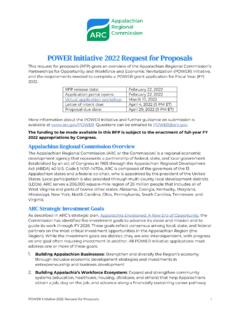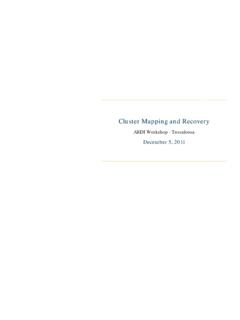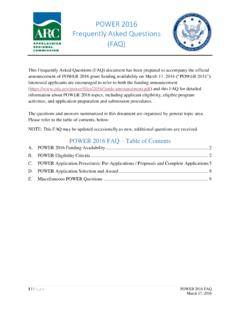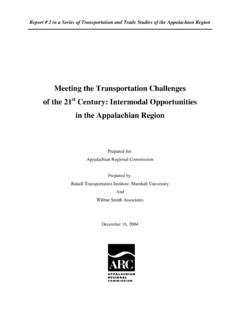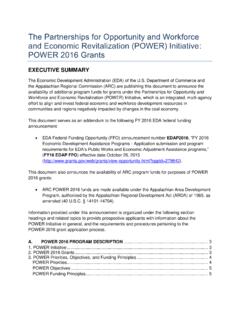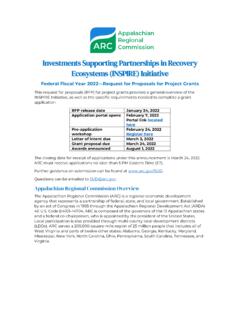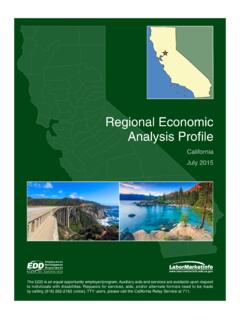Transcription of Trends in National and Regional Economic Distress: 1960-2000
1 Trends in National and Regional Economic distress : 1960 -2000 Prepared for the Appalachian Regional Commission by Lawrence E. Wood Assistant Professor College of Communication Ohio University Athens, Ohio April 2005 Table of Contents Part I: Introduction .. 1 Part II: The Federal Government and Regional Development .. 3 Part III: Research Design .. 6 Part IV: Result of Distressed Counties Analysis .. 13 Part V: Socioeconomic Characteristics of distress Nationally and Regionally .. 30 .. 31 Appalachia .. 37 Central Appalachia .. 39 Southern Appalachia .. 43 Northern Appalachia .. 47 The Mississippi Delta Region .. 49 The South .. 53 The Southwest .. 57 The Border Region.
2 61 Historically Non-Distressed Regions .. 65 Part VI: Conclusion .. 72 Bibliography .. 76 Appendix A: Information about Economic distress Status and Variables .. A-1 Appendix B: Regions as Identified in this Research .. B-1 Appendix C: Logistic Regression Models .. C-1 2 Part I: Introduction The 1960s marked an era when the federal government had become increasingly concerned with addressing the socioeconomic problems of lagging regions and communities in the Emblematic of this concern was the creation of agencies such as the Area Redevelopment Administration (ARA), the Economic Development Administration (EDA), and the Appalachian Regional Commission (ARC). While the EDA and ARC have continued in their attempts to promote development and social well being since the 1960s the EDA operating throughout much of the nation and the ARC working within the Appalachian Region since the early 1980s federal funding to these agencies has dropped considerably.
3 In the meantime, while a number of other Regional development commissions have either been created or proposed at the federal level in recent years, including the Delta Regional Authority, the Denali Commission, and the Southwest Regional Border Authority, these commissions have invariably been poorly funded or have not yet gathered the political support necessary to gain Congressional approval. From the perspective of federal Regional planning and development initiatives, the ARC is rather unique in scope, especially in its mandate and efforts to address issues of social and Economic concern in a specifically defined, historically lagging region of the In short, the ARC is the one federal Regional development commission that has a long history of trying to improve the socioeconomic conditions of a specifically defined region.
4 Since 1965 the commission has attempted to address development concerns in Appalachia by providing support for a wide range of projects, including the Appalachian Development Highway System (ADHS); public works projects such as water and sewer lines for homes, businesses, and industries; health initiatives aimed at creating subregional health networks; and educational projects for children as well as adults. The trajectory of federal support for ARC activities reflects changing perspectives regarding the federal government s role in addressing issues of Regional socioeconomic concern in the United States. In the 1960s and 1970s there was bipartisan agreement in Congress that problems of Regional Economic distress could not be solved by market forces alone. Beginning in 1980, however, a market-oriented standpoint became ascendant and gained momentum over the next two decades as bipartisan view that held that the market mechanism should be relied on to resolve Regional Economic problems.
5 The history of activities within the ARC itself also demonstrates changing views over time regarding how best to address issues of socioeconomic distress . The commission has gone from a congressional mandate that initially focusing its efforts in the urban growth centers of the Appalachian Region, to a shift in the mid-1980s towards concentrating its resources on the rural, distressed counties of Appalachia. Other recently created or proposed commissions share a similar focus on distressed areas. This research addresses the question of what has happened between the 1960s the time when the federal government took on a previously unparalleled commitment to address Regional socioeconomic concerns and the present, where approximately two decades have passed since the federal government considerably backed off from these earlier efforts.
6 This report attempts to answer this question by examining changing socioeconomic conditions throughout the between 1960 and 2000. Specifically, this research assesses National and Regional socioeconomic conditions directly prior to the inauguration of agencies such as the EDA and 3 ARC, and then examines how various regions in the have fared since that time. In particular, this research analyzes the following issues: 1) The changing nature of Economic distress between 1960 and 2000, nationally as well as regionally, utilizing a consistent measure of Economic distress , specifically an Economic distress measure developed by the ARC. 2) Regional Economic Trends throughout the in terms of the individual indicators that comprise the ARC s distress measure, which includes poverty rates, levels of income, and unemployment rates.
7 3) Social and Economic Trends at the National and Regional level utilizing various indicators that are not included within the ARC s distress measure, including, for example, rates of educational attainment, levels of urbanization, and a measure of Economic diversity. This report is an extension of previous research that examined changing patterns of Economic distress over time in Appalachia during the period 1960 to Similar to the previous research, this report utilizes the ARC s current measure of Economic distress to assess the Economic status of counties in the Appalachian Region over time, though it extends the previous research by utilizing recently released data from the 2000 census to examine distress conditions in Appalachia in the year 2000. Moreover, this research further extends the previous research by providing a more precise understanding of the changing nature of Economic distress in other regions of the These regions include those that, like Appalachia, have historically had economically distressed conditions, such as the Mississippi Delta Region and the South, as well as regions that have had relatively strong Economic conditions over time, including New England and the Mid-Atlantic Moreover, as this research will demonstrate, amidst at least some Economic improvement throughout much of the since the 1960s, Regional Economic distress has grown in some parts of the country, including in the Border Region.
8 Like the previous report, an important component of this research is the determination of socioeconomic factors associated with persistent Economic distress , as well as factors associated with counties graduating out of Economic distress status over time. Thus, this analysis not only calculates Economic distress over time, but it also provides corresponding statistical analyses that offer an indication as to why some counties, at the National as well as Regional levels, have been able to move out of Economic distress since the 1960s, while others have remained mired in distress throughout much of the past forty years. Again, this research extends the previous analysis by examining in detail these issues in various regions of the This analysis details socioeconomic change in Appalachia and other regions of the , and provides relevant benchmarks for assessing Regional and National socioeconomic change from the period directly prior to the establishment of agencies such as the ARC, to the present.
9 Results of this research indicate that the trend over the past couple of decades of limited federal support for Regional development activities may not be very well justified. 1 See Wood and Bischak (2000). 2 For information on all the regions assessed in this research, see Appendix B. 4 Part II: The Federal Government and Regional Development While the 1960s marked a time when the federal government became particularly concerned with addressing the socioeconomic problems of lagging regions, the federal government has a long history of being involved in activities that have had a direct effect upon Regional and local Economic development. For example, federal road building efforts of the early 20th century are understood to have affected local and Regional development throughout parts of the However, in spite of such activities, federal planning and development efforts prior to and extending through the first few decades of the 1900s should be understood as without particular Regional This practice changed in 1933 with the inauguration of the Tennessee Valley Authority (TVA)
10 , which is typically recognized as the federal government s first foray into multi-state, regionwide development At the same time, and despite the improvement in socioeconomic conditions that resulted from its efforts, the TVA s activities were primarily rooted in an effort to control floods and develop resources and means for energy rather than to address Regional socioeconomic concerns in particular. Nonetheless, TVA development projects as well as similar projects elsewhere in the throughout the 1930s, 1940s, and 1950s, led to outcomes directly related to Regional development, including the provision of electricity; the development of water resources; flood control; the development of recreational facilities; and increased agricultural land use through erosion control and reforestation Despite these activities, federal government initiatives principally focused on Regional Economic and social development did not begin until the early 1960s.
